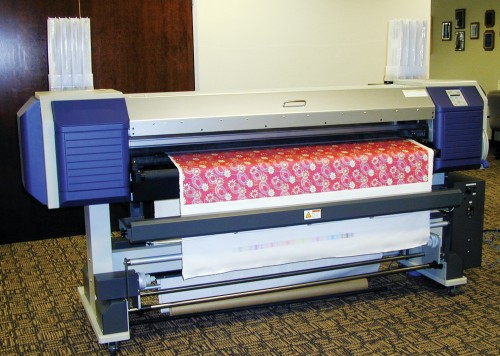Not all fabrics are equal
Fabrics are produced with all types of textures and other attributes. The choice of fabric will depend on the application.
There are stretchy and non-stretchy options, for example, as well as fire-retardant coatings that are required by some building codes for indoor graphics. As mentioned before, a fabric with high pass-through quality is needed for flags. Strength, durability and shrinkage also vary by material.
Further, fabrics produced with non-dye-sublimation printing in mind are finished with different coatings for use with different popular ink sets (e.g. solvent or latex), as ink-to-fabric compatibility is a significant factor in an application’s success. It is a question of how well the coating holds the ink drops.

Wide-format textile printers that can handle a greater variety of fabrics— including stretch fabrics—have strong potential for the sign industry.
Finishing and displaying
The most common type of finishing for fabric graphics and flags is sewing, but other options include hot-knife cutting, glue, rivets and tape. Grommets can be added to the fabric to create hanging signs.
Silicone-edge graphics are proving very popular due to their versatility in terms of sizes and shapes. Unlike fabric graphics finished with bead or pole pockets, the sew line is hidden within the extrusion, providing a cleaner look for frontlit and backlit exhibits and POP wall displays. With the silicone edge offering a less visible frame, people see more graphic and less hardware.
Other common display hardware options include retractable banner stands, lightweight pop-up ‘pillow case’ structures and tear drop frames, all of which can be set up without needing special tools.
The value of fabrics
Fabric graphics represent a growing market. If a sign shop does not serve this market, then its competitors will.
Fortunately, fabric printing can be as easy as vinyl printing—and the profit margins are much higher, due to the perception of fabrics’ richer, higher value. The customer saves money anyway, though, through lower costs for shipping, storing and installation.
Ken Bach is business development director for Aberdeen Fabrics, a mill that produces fabrics specifically for the sign and graphics industry. He will be discussing dye sublimation and fabric graphics at ImagiNation 2014, a Roland DGA inkjet user conference on October 21 in Las Vegas, Nev. For more information, contact him via e-mail at kbach@aberdeenfabrics.com and visit www.rolanddga.com/imagination.





